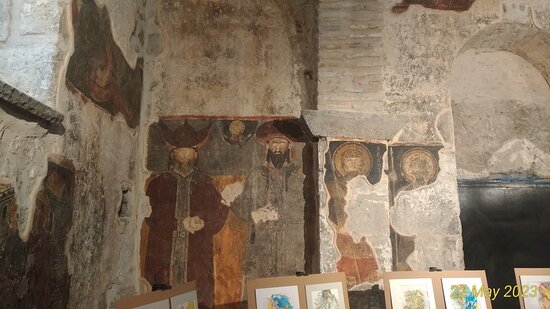The Church Saint Anna (Greek: Ἁγία Άννα, Turkish: Küçük Ayvasıl Kilisesi) is the earliest of the churches that survive today in the Turkish city of Trebizond (Trabzon), dating to the 6th or 7th century. It has not seen service in over a century, but has recently (2021-22) been thoroughly restored. With whitewash removed, all remaining fresco's have now become visible. The church is accessible to the public free of charge during daytime hours.
It is a monument directly linked to the actions of officials, who at various times contributed to its renovation or made simple donations. The importance of the church is also underlined by its timelessness: for about 700 years, from the 9th to the 15th century, interventions and donations were made to it, as the inscriptions testify.
The cemetery character - tombs and inscriptions that commemorate the date of death of specific persons - dominates in Saint Anna. The same is true of other, very important churches in Trebizond: in Hagia Sophia, in Theoskepastos, in Chrysokefalo. However, if the last three monuments are intertwined with the local imperial dynasty of the Great Komnenoi, Saint Anna seems to constitute the funerary institution of local officials.
It is a monument directly linked to the actions of officials, who at various times contributed to its renovation or made simple donations. The importance of the church is also underlined by its timelessness: for about 700 years, from the 9th to the 15th century, interventions and donations were made to it, as the inscriptions testify.
The cemetery character - tombs and inscriptions that commemorate the date of death of specific persons - dominates in Saint Anna. The same is true of other, very important churches in Trebizond: in Hagia Sophia, in Theoskepastos, in Chrysokefalo. However, if the last three monuments are intertwined with the local imperial dynasty of the Great Komnenoi, Saint Anna seems to constitute the funerary institution of local officials.
The surviving building, a three-aisled vaulted basilica with a crypt for tombs, is due to the sponsorship of a local official, the protospatharios Alexios, for the renovation of the church in 884/5. The content of the inscription that commemorates him constitutes impressive and valuable historical information, as it mentions the Byzantine/Roman emperors of the Macedonian dynasty, Basil I, Leo VI and Alexander. This is a unique testimony to the contact of this remote province with the Byzantine capital.
The history of the monument therefore begins long before the establishment of the Great Komnenian Empire in the 13th century. However, during the 14th and 15th centuries the foundation was associated with the death, and in all probability with the burial, of mainly ecclesiastical dignitaries. A total of seven inscriptions from this period, the majority of which are funerary and in some cases accompanied by the portraits of the deceased, are indicative of the atmosphere that would have prevailed inside the temple. Unfortunately, the material that composes the above image is now considered definitively lost. However, only photographic material and the designs of publications from the late 19th and early 20th centuries can give us an idea.
The history of the monument therefore begins long before the establishment of the Great Komnenian Empire in the 13th century. However, during the 14th and 15th centuries the foundation was associated with the death, and in all probability with the burial, of mainly ecclesiastical dignitaries. A total of seven inscriptions from this period, the majority of which are funerary and in some cases accompanied by the portraits of the deceased, are indicative of the atmosphere that would have prevailed inside the temple. Unfortunately, the material that composes the above image is now considered definitively lost. However, only photographic material and the designs of publications from the late 19th and early 20th centuries can give us an idea.
Precisely because the monument underwent many interventions and additions over time, its painted decoration dates back to various periods. Thus, in addition to the first phase of wall painting, which has been dated to the 12th century, layers of paintings from the 13th, 14th and 15th centuries have been identified. Today we are not in a position to evaluate these wall paintings, since they were already in poor condition from the beginning of the century.
However, the existence of the funeral portraits of the 14th and 15th centuries alone is certainly of particular interest. Also, according to the dedication of the church, a cycle of scenes with the protagonists of the Virgin Mary's parents, Joachim and Anna, is also found in the wall paintings. The depiction of their death is a rare composition for the data of Byzantine art. Apart from this, however, it contributes to the view of the funerary use of the monument and is harmoniously combined with the funeral portraits.
However, the existence of the funeral portraits of the 14th and 15th centuries alone is certainly of particular interest. Also, according to the dedication of the church, a cycle of scenes with the protagonists of the Virgin Mary's parents, Joachim and Anna, is also found in the wall paintings. The depiction of their death is a rare composition for the data of Byzantine art. Apart from this, however, it contributes to the view of the funerary use of the monument and is harmoniously combined with the funeral portraits.








